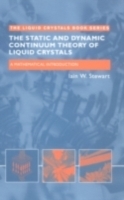Detailansicht
Static and Dynamic Continuum Theory of Liquid Crystals
eBook - A Mathematical Introduction, Liquid Crystals Book Series
ISBN/EAN: 9780203646335
Umbreit-Nr.: 3628614
Sprache:
Englisch
Umfang: 351 S.
Format in cm:
Einband:
Keine Angabe
Erschienen am 29.06.2004
Auflage: 1/2004
E-Book
Format: PDF
DRM: Adobe DRM
- Zusatztext
- Given the widespread interest in macroscopic phenomena in liquid crystals, stemming from their applications in displays and devices. The need has arisen for a rigorous yet accessible text suitable for graduate students, whatever their scientific background. This book satisfies that need.The approach taken in this text, is to introduce the basic continuum theory for nematic liquid crystals in equilibria, then it proceeds to simple application of this theory- in particular, there is a discussion of electrical and magnetic field effects which give rise to Freedericksz transitions, which are important in devices. This is followed by an account of dynamic theory and elementary viscometry of nemantics Discussions of backflow and flow-induced instabilities are also included. Smetic theory is also briefly introduced and summarised with some examples of equilibrium solutions as well as those with dynamic effects. A number of mathematical techniques, such as Cartesian tensors and some variational calculus, are presented in the appendices.
- Kurztext
- Given the widespread interest in macroscopic phenomena in liquid crystals, stemming from their applications in displays and devices. The need has arisen for a rigorous yet accessible text suitable for graduate students, whatever their scientific background. This book satisfies that need.The approach taken in this text, is to introduce the basic continuum theory for nematic liquid crystals in equilibria, then it proceeds to simple application of this theory- in particular, there is a discussion of electrical and magnetic field effects which give rise to Freedericksz transitions, which are important in devices. This is followed by an account of dynamic theory and elementary viscometry of nemantics Discussions of backflow and flow-induced instabilities are also included. Smetic theory is also briefly introduced and summarised with some examples of equilibrium solutions as well as those with dynamic effects. A number of mathematical techniques, such as Cartesian tensors and some variational calculus, are presented in the appendices.
